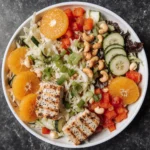Volume Eating Recipes: The Ultimate Guide for Weight Loss Without Hunger
- Prep Time: 10 min
- Cook Time: 10 min
- Total Time: 20 min
- Yield: 2 servings (1 large bowl per serving) 1x
- Category: Lunch, Dinner
- Cuisine: American
- Diet: Low Calorie
Ingredients
-
For the lemon-ginger dressing:
- ½ teaspoon lemon zest
- ½ cup lemon juice, fresh squeezed
- 1 teaspoon grated ginger, fresh
- 2 tablespoons avocado oil
- 2 tablespoons maple syrup (optional; can use regular or sugar-free syrup)
- salt and pepper, to taste
For the chicken salads:
- 8 cups mixed salad greens
- 6 ounces cabbage, shredded (170 grams)
- 1 medium cucumber, chopped (½-inch dice, 1.27 cm)
- 1 medium red pepper, chopped (½-inch dice, 1.27 cm)
- 1 cup mandarin orange segments, drained
- 12 ounces grilled chicken, chopped (340 grams; can substitute chopped rotisserie chicken breast)
- 4 scallions, sliced
- 2 ounces chopped cashews (57 grams; approximately ½ cup)
Instructions
To make the lemon-ginger dressing:
-
Place the zest, juice, ginger, oil, syrup, salt, and pepper in a one-cup canning jar. Put the lid on the jar and shake to combine the ingredients.
-
Set the dressing aside while you assemble the salads.
To make the chicken salads:
-
Shred cabbage, chop cucumber and bell pepper, and slice the scallions. Chop the grilled chicken breast into bite-sized pieces.
-
Distribute the mixed greens and cabbage evenly between four salad containers.
-
Top the greens with the cucumber, pepper, mandarin oranges, and chicken. Try to distribute these ingredients evenly between the four containers.
-
Garnish the salads with sliced scallions and cashews. Add the dressing right before serving.
-
You’re all ready for lunch for the next four days!
Notes
This is a Level 1 recipe, which may help support fat loss. Remember, weight loss ultimately requires maintaining a calorie deficit — consuming fewer calories than your body burns. One smart approach is to focus on high-volume, low-calorie, high-protein meals, which allow you to eat more food while taking in fewer calories. If you’re someone who enjoys feeling full and satisfied at meals, volume eating can be especially helpful.
Volume eating recipes are typically low in fat, but high in fiber and fluid volume. This matters because water adds bulk without calories, whereas fat contains 9 calories per gram — over twice the calorie density of carbs and protein, which each provide just 4 calories per gram. That’s why loading up on veggies and lean proteins can leave you feeling full without overloading on calories.
Making a volume eating salad that supports weight loss is easier than you might think. The key is to keep it low in fat while building in plenty of volume with fruits and vegetables. To make your salad truly satisfying, include a solid serving of protein, which is considered the most filling macronutrient.
If you have higher energy needs or want to increase the calorie content, simply add more cashews, include a side of whole grain crackers, or pair your meal with a carton of milk — which not only adds calories but also helps cover an additional food group.
Finally, feel free to customize your salad with ingredients that suit your preferences. For example, fresh snow peas would be a great veggie swap that keeps your meal crunchy, colorful, and satisfying.
Nutrition
- Serving Size: 1 bowl (approx. 420g)
- Calories: 375 kcal
- Sugar: 9g
- Sodium: 410mg
- Fat: 14.5g
- Saturated Fat: 2g
- Unsaturated Fat: 11.5g
- Trans Fat: 0g
- Carbohydrates: 28g
- Fiber: 6g
- Protein: 29.3g
- Cholesterol: 65mg
Keywords: Rotisserie chicken breast, sugar free, mandarin orange,Cauliflower rice, chicken breast, broccoli, zucchini, beans,Broad beansInstant brown rice, chili sauce, soy sauce, baby carrots,
Find it online: https://www.isvecbahis.info/volume-eating-recipes/
